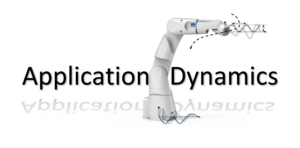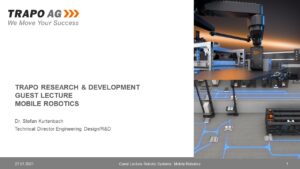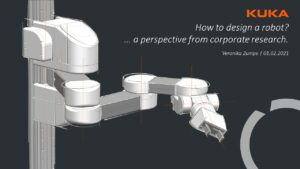Schlagwort: ‘Roboterprogrammierung’
Semi-Automated Tile-Laying Aid
Der an dieser Stelle eingebundene Inhalt führt Sie auf Seiten, die von der von Google betriebenen Seite YouTube - YouTube, LLC, 901 Cherry Ave., San Bruno, CA 94066, USA - zur Verfügung gestellt werden. Mit dem Aufruf des Inhalts kann YouTube Ihre IP-Adresse und die Sprache des Systems, sowie verschiedene browserspezifische Angaben ermitteln. Wenn Sie in Ihrem YouTube-Account eingeloggt sind, ermöglichen Sie YouTube, Ihr Surfverhalten direkt Ihrem persönlichen Profil zuzuordnen. Dies können Sie verhindern, indem Sie sich aus Ihrem YouTube-Account ausloggen. YouTube verwendet Cookies und Tracking-Tools. Die Datenverarbeitungsvorgänge sowie die Zwecke der Verarbeitung können direkt bei YouTube erfragt und eingesehen werden.
As part of the ErgoFli project, an innovative system is being developed in collaboration with project partners to help tile layers make their work more ergonomic and efficient.
In the video you can see how the system works in the Gazebo simulation environment. The robot automatically removes tiles from a magazine and matches them perfectly to the tiles already laid. With automatic processes, several tiles can be laid in succession to optimize the work process.
Our aim is to create a tool that not only reduces the workload for tilers, but also improves their working environment. We are excited about the progress and look forward to sharing more insights with you soon!
Find out more about the project here.
Contact person:
Mark Witte
Jan Wiartalla
Robot Cooking – Transferring observations into a planning language
Transferring observations into a planning language: An automated approach in the field of cooking
In the Robot Cooking project, an automated method is developed to analyze and identify motion data and convert it into a machine-readable planning language. This is done using a cooking scenario as an example in which the motion data is captured by recording the hand pose of the cook.
The recording is done using a motion capture system consisting of seven cameras and a glove with three markers on the back of the chef’s hand. The position of the markers is determined by triangulation. This provides enough information to derive the hand pose. The recording is done at 120 frames per second. Before the cooking process, all objects in the workspace are identified and their initial positions determined. Motion data is continuously recorded and converted into poses with time stamps. Additional information such as velocity, acceleration and angle in relation to the tabletop are derived from the raw data.
A initial structure of the dataset is created by finding the side actions using classification. Here, pick, move and place are identified as recurrent side actions. A separate training dataset is used to train a classifier that recognizes these actions. This enables an easier analysis of the remaining actions.
Clustering is applied to identify unknown actions. A dynamic approach allows analysis despite high variability in execution. A unique fingerprint for each action is found, based on the orientation of the back of the hand and its speed on the table plane, to assign each frame to a cluster and finally to an action.
The knowledge gained from classification and clustering is translated into a machine-readable Planning Domain Definition Language (PDDL). A schedule is created, with known actions directly assigned. Start and end positions are specified, and virtual object tracking is used to represent the progression of objects during cooking. For unknown actions, preconditions and effects are handled dynamically. The results are translated into a machine-readable PDDL. This formal representation enables efficient automatic scheduling and execution of the previously demonstrated cooking task.
Additional information is available in the video linked above, the poster and the paper.
Contact:
Markus Schmitz
First movement of PARAGRIP with new control unit
PARAGRIP’s control architecture has been completely redesigned in order to be fully equipped for its future tasks in multidirectional additive manufacturing (MDAM) with arc welding (WAAM). The movements of all four arms can now be planned, simulated and executed on the real robot using MoveIt in ROS2. The joint positions of the physical robot are always fed back to ROS2, allowing the integration of online planning algorithms in the future. The video shows the planning and execution of a simple test motion of the PARAGRIP.
More information about the project can be found here.
Contact: Jan Wiartalla
A multi-layered task sequencing approach
Cobots are highly sought by manufacturing companies in contrast to fully automated production lines, as they provide the additional benefit of flexible operations. A major hurdle with current collaborative setups is tedious setup times for efficient and robust co-working as well as poor support for random interruptions.
This project focuses on enabling autonomous collaborative operations for serial manipulators where interruptions from human agents occur at random while ensuring minimal setup times. To this end, two primary aspects that impact task execution are addressed, namely execution time and co-working as enumerated below:
- A method is developed to minimise the total distance travelled, by following the most optimal sequence for the given task while retaining online operational capabilities
- A real-time replanning and co-working algorithm for randomly interruptive environments is developed and implemented to ensure continued operation even when regions of the workspace are occluded while guaranteeing safety of the human agents in the workspace. The co-working controller operates fully autonomously.
An example of the working of the deployed on a prototype platform consisting of a collaborative UR10e arm, a stereo camera for static environment mapping and a laser scanner for mapping of dynamic obstacles is shown in the video.
Contact: Daniel Gossen
music: madiRFAN – Both of Us (https://pixabay.com/music/beats-madirfan-both-of-us-14037/)
Watch the video on our Youtube channel: here.
Lösungen der Praktischen Übungen in Robotic Systems
Auch in diesem Jahr haben uns wieder kreative Lösungen für Problemstellungen aus dem Modul Robotic Systems erreicht. Die Studierenden konnten erste Erfahrungen bei der Programmierung eines Fanuc Roboters in Roboguide sammeln. Eine Umfangreiche Programmieraufgabe galt es weiterhin an der Fanuc Education Cell zu lösen. Auf Grund der Einschränkungen der Präsenzveranstaltungen mussten alle Lösungen virtuell in Roboguide gelöst werden. Im nächsten Winter wird dann wieder am realen Roboter erprobt.
Ansprechpartner:
IGMR Seminar 08.02.2021 14:30 Uhr: Dr. Stefan Kurtenbach, Trapo AG
Wir begrüßen Dr. Stefan Kurtenbach von der Trapo AG zum IGMR Seminar. Auch diese Veranstaltung wird weiterhin virtuell durchgeführt:
Der Vortrag von Dr. Kurtenbach wird einen Eindruck der aktuellen Entwicklungen und Produkte von der Trapo AG geben.
Trapo Research and Development: Mobile Robotics
Montag, 08. Februar 2021 14:30 Uhr
Zoom Meeting Informationen:
https://rwth.zoom.us/j/98454895570?pwd=NkpiSWkyaTJtdWlralJrSUtnMDdDZz09
Meeting-ID: 984 5489 5570
Kenncode: 186393
Die Datenschutzhinweise zur Nutzung von Zoom und eine Handreichung für Teilnehmer (Studierende) können von den Seiten des CLS der RWTH Aachen University heruntergeladen werden.
Die Veranstaltungen im Wintersemester 2020/2021 werden in Zusammenarbeit mit dem VDI-GPP-Arbeitskreis des Bezirksvereins Aachen durchgeführt.
Weitere Informationen zum Thema können den folgenden Blogeinträgen entnommen werden:
Industrieprojekt Trapo Loading System
Ansprechpartner:
IGMR Seminar 01. Februar 2021 14:30 Uhr: Veronika Zumpe, Kuka AG
Wir begrüßen Frau Veronika Zumpe von Kuka zum IGMR Seminar. Auch dieser Veranstaltung wird weiterhin virtuell durchgeführt:
How to design a robot. A perspective from corporate research.
For specific handling tasks, there is a need for the development of new robotic systems. It is necessary to develop and design the system with respect to the given task, environment and other constraints. The design process includes finding a suitable kinematic, developing drive concepts for the robot axes, designing the structural parts and finalizing the robot design. For applications with human robot collaboration, more aspects like lightweight design play a significant role and thus should be taken into account. This talk gives a rough overview of the design process of a robot from my corporate research perspective.
Montag, 01. Februar 2021 14:30 Uhr in Zoom
https://rwth.zoom.us/j/98454895570?pwd=NkpiSWkyaTJtdWlralJrSUtnMDdDZz09
Meeting-ID: 984 5489 5570
Kenncode: 186393
Die Datenschutzhinweise zur Nutzung von Zoom und eine Handreichung für Teilnehmer (Studierende) können von den Seiten des CLS der RWTH Aachen University heruntergeladen werden.
Die Veranstaltungen im Wintersemester 2020/2021 werden in Zusammenarbeit mit dem VDI-GPP-Arbeitskreis des Bezirksvereins Aachen durchgeführt.
Ansprechpartner:
IGMR Seminar 26.01.2021: Robert Grafe, Deutsches Rettungsrobotik-Zentrum e.V.
Unbemannte Systeme in der Gefahrenabwehr, der Aufbau des Deutsches Rettungsrobotik-Zentrums.
https://youtu.be/anZtJAajQy0
Wir begrüßen Herrn Grafe vom DRZ zum IGMR Seminar. Auch dieser Veranstaltung wird weiterhin virtuell durchgeführt:
Unbemannte Systeme in der Gefahrenabwehr, der Aufbau des Deutsches Rettungsrobotik-Zentrums Die Nutzung unbemannter, bodengebundener Systeme bietet großes Potential, Einsatzkräfte von Hilfsorganisationen und Feuerwehren bei besonders gefährlichen oder zeitraubenden Einsätzen zu unterstützen. Auf Grund der anspruchsvollen Aufgaben und Szenarien ist der Sprung von der Forschung in die reale Nutzung jedoch bisher nur vereinzelt geglückt. Der Vortrag stellt diesen Stand von Forschung und Entwicklung dar und beschreibt den Ansatz, welcher mit der Gründung des Deutschen Rettungsrobotik-Zentrums beschritten wird, um die Realisierung von praxis-/ und produktnahen Lösungen zu fördern.
Dienstag, 26. Januar 2021 16:30 Uhr in Zoom
Zoom Meeting Informationen:
https://rwth.zoom.us/j/98454895570?pwd=NkpiSWkyaTJtdWlralJrSUtnMDdDZz09
Meeting-ID: 984 5489 5570
Kenncode: 186393
Die Datenschutzhinweise zur Nutzung von Zoom und eine Handreichung für Teilnehmer (Studierende) können von den Seiten des CLS der RWTH Aachen University heruntergeladen werden.
Die Veranstaltungen im Wintersemester 2020/2021 werden in Zusammenarbeit mit dem VDI-GPP-Arbeitskreis des Bezirksvereins Aachen durchgeführt.
Weitere Informationen können auch dem Blog-Beitrag IGMR als Mitglied des Deutsches Rettungsrobotikzentrum e.V entnommen werden.
Ansprechpartner:
TCP and null space impedance for bypassing objects with the KUKA iiwa
In the video two different types of impedance control of the KUKA iiwa are shown: TCP and null space impedance. Furthermore, the bypassing of objects using impedance control has been implemented.
https://youtu.be/VHrV-nh5oTU
First, the two different types of impedance control are demonstrated. Different stiffnesses can be programmed around the individual TCP axes. Two different stiffnesses within a plane are shown in the video. On the other hand, there is null space impedance. In this case, the robot maintains the pose of the TCP and the elbow can be pushed away. As shown in the video, this can be used to bypass an object while maintaining the programmed TCP path.
Project page: NextGeneration
Contacts:






